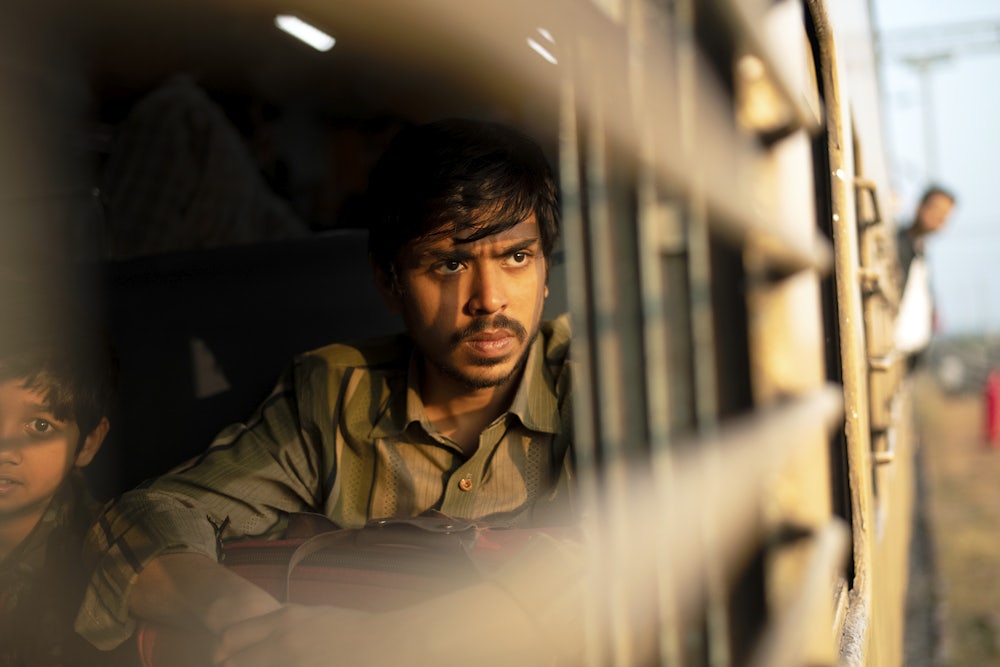At first it may seem like Ramin Bahrani’s The White Tiger is another “poverty porn” film, a rising Hollywood genre in the mold of Slumdog Millionaire and Million Dollar Arm, in which Indian street urchins improbably rise from rags to riches. India’s abject socioeconomic and living conditions have been a cash cow for Hollywood studios capitalizing on caste oppression and economic backwardness. These movies stitch together digital-age Dickensian tales of token Indian individual exceptionalism, as if to say: Homeless, hungry, and uncertain of your fate? Worry not, for you’re just a television game show or a Major League Baseball scout away from a place in the stars.
Thankfully, that’s not the agenda of Bahrani’s adaptation of Aravind Adiga’s Booker Prize–winning novel, a Wolf of Wall Street–style tale told from the perspective of a ruthless ladder-climber. Indeed, in the same way that Jordan Peele’s Get Out subverted the blaxploitation film, Bahrani has thrown a wrench in the Western viewer’s self-congratulatory streaming pleasure by grounding his rags-to-riches story in the horrors of the “rags” part. Moreover, as has been characteristic of his two-decade career making gut-churning portraits of working poor and immigrant life, the Iranian-American filmmaker depicts the inherent violence of that ladder-climbing, toward both the self and others.
The central character in The White Tiger is Balram Halwai (Adarsh Gourav), a lowly rickshaw-puller’s son who claims that he has “woken up while the rest are still sleeping,” and so is able to “look at his country directly,” channeling V.S. Naipaul in 1964’s An Area of Darkness. (“It is well that Indians are unable to look at their country directly,” Naipaul wrote, “for the distress they would see would drive them mad.”) Consequently, Balram can no longer “continue to squat among the ruins,” as Naipaul put it.
While Balram strives to cash in on India’s I.T. boom, Bahrani makes clear that this slumdog, who hails from a peasant caste, is aware that he’s trapped in his father’s toil, lugging people places that he’ll never enter. Instead of pulling a rickshaw like his father, Balram manages a slight upgrade, steering an air-conditioned SUV, in which he chauffeurs Ashok (Rajkumar Rao), son of a gangster known as The Stork (Mahesh Manjrekar).
Whereas Bollywood leading men have historically staged upper-caste displays of “anger” toward socials ills in films, Gourav as Balram gives the dehumanized lower-caste subject a place in the driver’s seat. Balram, who has no self, slowly grows one watching his born-into-money boss and his American-born fiancée act out a Bollywood romance in the rearview mirror. The White Tiger underscores its caste politics by casting Hindi-speaking villagers and help, against an English-speaking elite, including Priyanka Jonas, who plays Ashok’s fiancée, Pinky Madam. As a New York native, Pinky has an otherworldly presence in the impoverished Indian milieu, but as the daughter of a Queens bodega-owner is capable of showing far more solidarity with Balram than his gangster compatriots.
Thus, the film reveals how deep caste and class divisions are between the developers, the beneficiaries of development, and the never-to-be-developed, within “developing” India. Mixing metaphors, Bahrani characterizes brutally exploited and exploitative Indians as “chickens in a coop,” except one of them is born a white tiger, who figures out how to flee his cage. The coop is as much the satellite-city skyscraper apartment as the straw huts, in which hundreds of millions of Indians sleep hungry. Driving around Delhi and its ever-growing satellites, Balram bears witness to this tale of two cities as Ashok, the Stork, and a right-hand man, The Mongoose (Vijay Maurya), negotiate bribes with politicians such as the Great Socialist (Swaroop Sampath), parodying the self-enriching corruption that’s the flip side of “development” in India.
This is where I found Bahrani’s The White Tiger to be radical. True to the source material, it shows Balram eventually taking control of his life to an extent that eludes Indians of his means—including those whose necks he steps on along the way. But helped greatly by Paolo Carnera’s dreamy visuals, Bahrani delivers a cinematic moment that marks a departure from Adiga’s novel. Disillusioned by the elite class he serves, Balram in his powder-blue uniform shirt and navy-blue trousers weaves his way through scoops of human excrement in an abandoned patch of land—the type of area that, in the big city as well as bumblefuck India, doubles as public toilet. Pulling down his pants, he squats face-to-face with a fellow bottom-dweller, both baring their asses. Slowly, one smiles, the other mirrors him, and together they end up uncontrollably laughing.
Perhaps in keeping with mystical poet Rumi’s line, “Silence is the language of God,” Bahrani has delivered such transcendental wordless moments in his previous movies. In 2009’s Goodbye Solo, a Senegalese immigrant in Winston-Salem agrees to drive, for much-needed money, an old biker guy to Blowing Rock in the North Carolina mountains, from which the biker matter-of-factly says he will jump. In the lead-up to the event, the two become great friends, which makes saying goodbye a devastating experience that neither party can possibly have the right words for—so Bahrani leaves us with the two men taking a last fond look at each other from dueling distance. In 2014’s 99 Homes, a standoff involving cops and a resident about to be evicted holds a mirror to a Florida evictor’s cruelty, causing him to walk away from his soulless venture; the film abruptly closes with the smile of the child of the resident he opted not to evict. In The White Tiger, this transcendental wordlessness takes the form of two men realizing the absurdity of their situation—and their world.
Through this climactic nod to Naipaul’s merciless depiction of underdeveloped India, no matter how many fortunate individuals might escape it, Bahrani’s The White Tiger subverts the standard-issue poverty porno. In his review of the film, A.O. Scott noted that “there is an element of inwardness—a sense of the character’s struggles, desires, and motivations—that is missing.” He’s absolutely right, but isn’t that itself the crisis? For those who have come of age in India during its late nation-building project, it is difficult to answer the question, “What do you want?” without resorting to what Balram tells Pinky: “I want to serve you, Madam.” The inner struggle is that there’s nothing inside—a reflection of the lack of control over one’s own destiny. Gourav’s muted performance as Balram expresses this void; and his spare emotive outbursts land the necessary swipes to take down, once and for all, the myths of self-made heroes and saviors.








